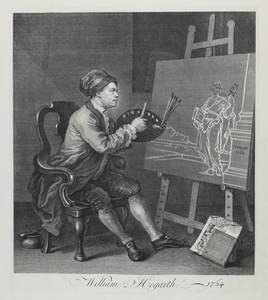| Method | Copper engraving and etching |
| Artist | William Hogarth |
| Published | [J & J Boydell c.1795] |
| Dimensions | Image 374 x 345 mm, Plate 405 x 355 |
| Notes |
A self-portrait of William Hogarth, after the oil painting now in the National Portrait Gallery. Hogarth sits in a high-backed chair, the arm of which features Hogarth's signature serpentine lines. His attire, fur-lined montero cap and painter's smock, matches the earlier self-portrait Gulielmus Hogarth (1748) upon which this portrait is based. In his right hand he holds an artist's blade, in his left a bunch of brushes and an oil palette. Behind the chair, another brush rests upon the rim of a chamber-pot. Hogarth works on a large canvas upon an easel, a small folio of engravings from the Analysis of Beauty resting against its leg. The subject of the preparatory sketch on the canvas is Thalia, the Muse of Comedy. This portrait replaced the earlier Gulielmus Hogarth as the frontispiece for publications of Hogarth's engravings, and continued to be used in this capacity after the artist's death in 1764. The current print is the final revision of the portrait, undertaken in Hogarth's final year. The artist's increasing pessimism is readily apparent in these final revisions. The artist's face, formerly smiling, is now grim. The face of Thalia likewise is scored by tragic lines in black, and the comic mask she now holds is that of a horned satyr. As Paulson suggests, with these small changes the plate is now laden with irony, as Hogarth's comedy is shown as nothing more than a mask to cover the artist's bitter pessimism. The title in the inscription space, replacing a longer dedication in earlier editions, now reads simply 'William Hogarth 1764.' William Hogarth (1697 - 1764) was born in London, the son of an unsuccessful schoolmaster and writer from Westmoreland. After apprenticeship to a goldsmith, he began to produce his own engraved designs in about 1710. He later took up oil painting, starting with small portrait groups called conversation pieces. He went on to create a series of paintings satirising contemporary customs, but based on earlier Italian prints, of which the first was The Harlot's Progress (1731), and perhaps the most famous The Rake's Progress. His engravings were so plagiarised that he lobbied for the Copyright Act of 1735, commonly referred to as 'Hogarth's Act,' as a protection for writers and artists. During the 1730s Hogarth also developed into an original painter of life-sized portraits, and created the first of several history paintings in the grand manner. Paulson 204 vii/vii Condition: Excellent impression with full margins. Waterstains, foxing, and time toning to margins, not affecting plate. Light crease to sheet. |
| Framing | unmounted |
| Price | £400.00 |
| Stock ID | 50667 |

